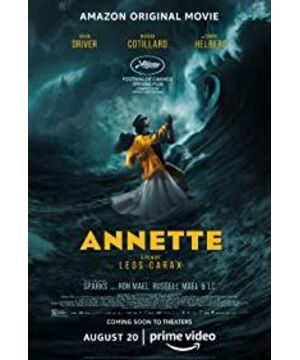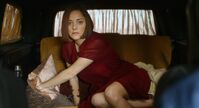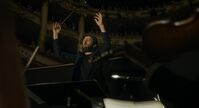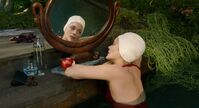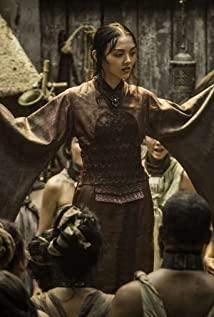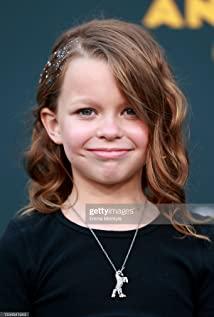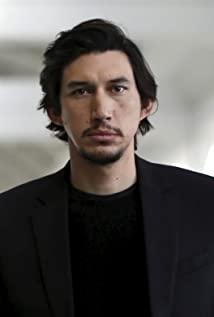When it comes to Leo Carax, we always think of his amazing talent. The new work, Annette, is very much in line with expectations and shows the qualities of Karax's work as always: top-notch fine art photography, meticulous editing and post-production, and a dramatic soundtrack. When a director makes a musical for the first time, his skills are fully displayed, and there is even room for dazzling skills.
The Cannes Film Festival desperately needs such an opening film, with a gorgeous lineup and pomp.
It can be said that both the movie itself and the scenes in the play, "Annette" is very gorgeous and pompous: the hero Henry is a little-known stand-up comedian, and the heroine Ann is a prosperous soprano singer. The love story of the two stage stars is naturally full of dazzling pictures: the spotlight, the big stage, the fine clothes and the food, and the beautiful appearance and figure. The married life of the two is closely watched, and the birth of their daughter Annette is also big news.
Such a story is undoubtedly eye-catching, especially for audiences who are keen on stand-up or stage play, "Annette" provides an unusual viewing experience: Ann's opera performance and Henry's stand-up performance are both recorded by the camera. Down, the movie audience is both the direct audience of Ann and Henry, and the onlookers of their performance.
Most of the dialogue in the private life of the two is presented in songs. The music of the whole film was produced by the American rock band Sparks, which not only tested the actors' acting skills, but also their singing skills.
Fortunately, Adam Driver and Marion Cotillard's performances, singing skills and physical expressions are very solid. In the scenes where singing is everywhere in life, the emotions and appeal of the characters are fully displayed in their singing.
When moviegoers watch the performance of the two characters, it will have an effect similar to a play within a play. The play-within-a-play that we are familiar with in the past is often that the actors who are the characters blur the boundaries of the play in the play they perform.
But "Annette" doesn't create the ambiguity of the play within the play, because the audience is always looking towards the stage, and when the audience offstage interacts with Henry and Ann, we cannot be part of that interaction.
But this does not prevent Henry and Ann from conveying emotion and energy to the audience in front of the screen. Henry's performances often use his own married life as a stand-up material. The audience in front of the screen can also clearly understand the joy conveyed at the moment of marriage or the gloom created by the unhappy marriage.
When Henry and Ann left the stage to return to married life, the duet between the two was a more direct self-expression. (Note: There are some spoilers below, please read with caution)
The first third of the film is when the husband and wife are in a relationship, and their love song is called "We Love Each Other So Much". In the second half of the film, the two were emotionally on the rocks, and they sang "let's Waltz in the Storm!" in the storm. The melody and lyrics of the two songs clearly express the emotional clues of the two.
Showing the love life of the two characters with song and dance performance is itself a form of expression with a strong sense of form. Therefore, Henry and Ann's married life is also full of ritual and drama, and even small movements such as scratching the soles of their feet seem like they are performing each other.
However, if the love life is made into a musical, if it is difficult to express naturally in the performance, it needs moving melodies and dreamy sets to decorate this exaggeration and unnaturalness, so as to eliminate the rigidity and artificiality.
The director Karax deliberately retained the characteristic of the musical "singing is speaking", so the characters always have a strong sense of performance in the interaction, very much like "Sacred Car Dealer", which integrates life and drama, regardless of each other's interests. condition.
This perception is especially evident in the first third of "Annette", because the context of love is not yet clear and the plot has not been emphasized.
It wasn't until the part where the relationship between the two took a turn for the worse that the plot unfolded more dramatically: Henry was unwilling to Ann's career success, and accidentally pushed her into the sea, becoming a single father raising his daughter alone. And Ann shrouded her resentment on Annette and used her daughter to get revenge on Henry. The exaggeration in the singing performance is balanced by the huge ups and downs of the plot and is more easily accepted by the audience.
As the title of the whole film, Annette plays a very special role. As the crystallization of the love between Henry and Ann, her birth naturally brings happiness, symbolizing the stability and peace of the family.
As Henry and Ann's relationship broke down, Annette became a tool for the two. Ann asked Annette to remind Henry of her own existence with a beautiful singing voice, while Henry used Annette's singing talent to make money for herself, bringing her daughter full world tour.
Until the end of the film, Annette's existence is as a symbol and symbol of her parents. Whether Henry and Ann's relationship is harmonious or not, Henry's state, and Ann's resentment are all reflected in Annette.
Karax does not give Annette the symbol any near-human quality. In fact, Annette is played by a puppet until the final scene of the film. From the big screen, the audience can clearly see the hinge joints, the wig, the stiff face without expression. The characters Adam Driver and Marion Cotillard have also been playing opposite the puppet.
As a symbol, the puppet's intention is very obvious: Annette is a puppet with no ego and is manipulated by others. Although this puppet can move and talk, it is not a living person after all, and the audience will naturally focus on Adam Driver and Marion Cotillard who are human. Everything that the puppet Annette reflects comes from Henry and Ann.
Until the very last scene, Annette resists Henry, accusing him and Ann of using her as a punching bag for their parents' failed relationship, and making it clear that they will not forgive and want to forget them. Eventually, the puppet falls to the ground, and Annette becomes a human, played by a real little girl.
Those who have their own will are no longer puppets. Although that self is not the self that Qianfan has been fully sublimated, and it has not produced a deafening and inspiring effect, the meaning of this change is very clear: the era when Henry and Ann were the protagonists of their daughters' lives has passed, and They also lost their audience, and nobody wanted to see them again.
This is undoubtedly a very fine drama marriage story. Indeed, some audience members said after the show that they could think of "Marriage Story" (also played by Adam Driver as the male protagonist), and the love-hate relationship between the characters was equally clear. The difference is that maybe "Annette" lacks a kind of emotional movement. From their falling in love to breaking up, it is difficult for the audience's emotions to flow with the ups and downs of the characters' fate.
If you watch "Annette" with the mentality of "La La Land", I am afraid you will be disappointed, because the plot is not always the focus of this movie. This is a work that focuses on expression, trying to break the wall between film and stage play. What Karax challenges is how to move singing and dancing to the screen, while retaining the taste and form of musicals, which is not the same as that of the big screen. The required fluidity conflicts with nature.
All in all, the movie "Annette" may not be touching enough, and it may be difficult for the audience to have a strong emotional resonance, but it is very skilled and wonderful.
Author | Lan Zhan; Official Account | Watching Movies and Seeing Dead Editor | Roof Riding Boy; Please indicate the source for reprinting
View more about Annette reviews


